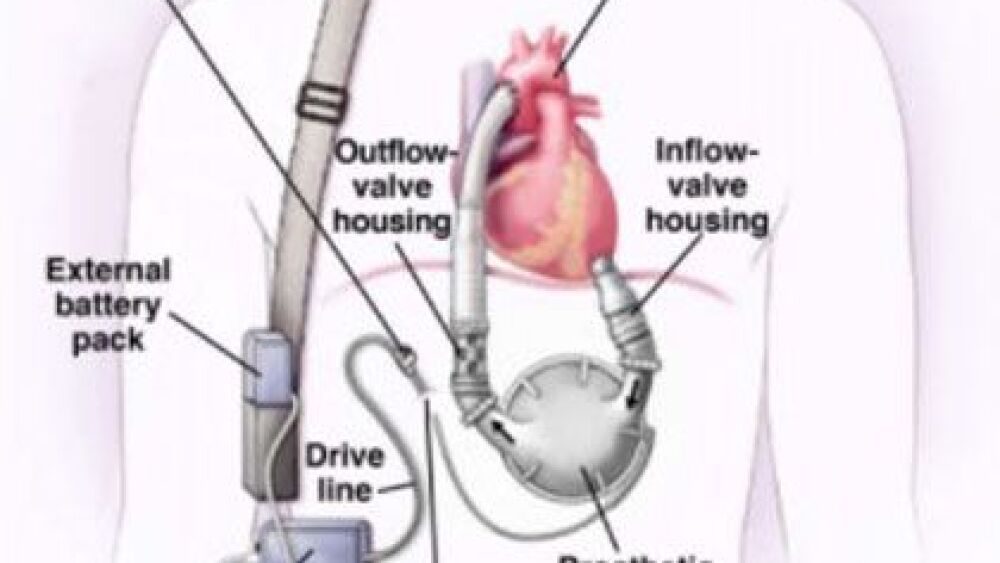This article originally appeared in the Evidence-Based EMS blog of the National Association of EMS Physicians and is reprinted here with permission.
By Stephanie Louka, MD
Case scenario: Paramedics are called to the home of a 59-year-old male patient with an LVAD who was found unconscious and unresponsive by family members. He was last seen two hours earlier acting normally. There is no evidence of trauma. Family members are unaware of any recent illness or mechanical issues with his LVAD.
Your assessment is notable for warm but pale skin, lack of palpable pulses, LVAD with low-flow alarm but audible hum and apneic respirations. After intubation, EtCO2 shows no wave form. How should paramedics proceed?
LVAD literature review
The 2015 ACLS guidelines do not address assessment and treatment of an unresponsive patient with a mechanical assist device such as an LVAD [1]. While there has never been a reported case of LVAD dislodgement resulting from chest compressions, for years, VAD manufacturers advised against routine use of chest compressions on these patients for fear of device dislodgement and rupture of the left ventricle.
Despite a lack of evidence of dislodgment, many hospitals and EMS systems adopted this advice in management of VAD patients and withheld chest compressions even in the setting of true cardiac arrest [2,3]. Alternatively, with the risk of dislodgement theoretical and death eminent, some institutions opted to go against the manufacturer recommendation and administer chest compressions in this setting.
In 2017, the AHA published its Scientific Statement on Cardiopulmonary Resuscitation in Adults and Children with Mechanical Circulatory Support in the journal Circulation, Offering the first evidence-based, consensus approach to management for unconscious and/or arresting patients with mechanical assist devices [4].
Relying heavily on physical exam and waveform capnography for assessment, the algorithm provides a systematic approach to management of LVAD patients. Trouble-shooting the LVAD with family members and/or LVAD coordinators is still recommended, but if the LVAD cannot be restarted or is not functioning adequately (MAP ≤ 50 mmHg and/or EtCO2 ≤ 20 mmHg), external chest compressions are now recommended.
While this AHA position was published in 2017, many EMS agencies are behind in adopting this change. As this policy makes its way into the ACLS Provider course curriculum and manual, and EMS personnel take their ACLS recertification courses, we should see broader adoption of this approach to the arresting LVAD patient.
LVAD Case resolution
The paramedic in charge contacted the regional VAD center and received online medical direction from the EMS physician on duty who instructed the crew to administer chest compressions and transport the patient to his facility. Firefighters on scene initiated chest compressions which resulted in a notable and sustained increase in EtCO2 levels.
The patient was transported to the emergency department where ROSC was obtained, and he was admitted to the ICU for continuing care.
Per the American Heart Association, chest compressions are now the standard of care in arresting patients with mechanical circulatory support devices (e.g. LVAD), and EtCO2 <20 for whom device troubleshooting was ineffective.
References
1. American Heart Association (AHA). Advanced Cardiovascular Life Support (ACLS) Provider Manual, 16th edition. 2016.
2. Shinar Z, Bellezo J, Stahovich M, Cheskes S, Chillcott S, Dembitsky W. Chest compressions may be safe in arresting aptients with left ventricular assist devices (LVADs). Resuscitation. 2014 May; 85(5):702-4.
3. Mabvuure NT, Rodrigues JN. External cardiac compression during cardiopulmonary resuscitation of patients with left ventricular assist devices. Interactive CardiVascular and Thoracic Surgery. 2014 Aug; 19(2):286-289.
4. Peberdy MA, Gluck JA, Ornato JP, et al. Cardiopulmonary Resuscitation in Adults and Children with Mechanical Circulatory Support. Circulation. 2017 Jun 13;135(24):e1115-e1134.
About the author
Stephanie Louka, MD, is an EMS Fellow and completed her Emergency Medicine residency training at VCU Health in Richmond, Va. Originally from Virginia Beach, Va., she is a life-member of the Virginia Beach Volunteer Rescue Squad. Her prehospital interests include POCUS and BLS education. She blogs at TeamLouka.com.



